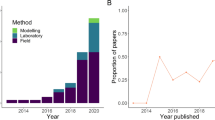Abstract
Studies on the effects of a variety of exogenous and anthropogenic environmental factors, including endocrine disruptors, heavy metals, UV light, high temperature, and others, on marine organisms have been presented at the 2nd Bilateral Seminar Italy–Japan held in November 2006. Reports were discussed in order to reveal the current situation of marine ecosystems, aiming at evaluation and prediction of environmental risks.
Similar content being viewed by others
Notes
Women in History. http://www.lkwdpl.org/wihohio/cars-rac.htm; The Rachel Carson Institute. http://www.chatham.edu/RCI/; The Life and Legacy of Rachel Carson. http://www.rachelcarson.org/; The Rachel Carson Homestead. http://www.rachelcarsonhomestead.org/; Rachel Carson National Wildlife Refuge. http://www.fws.gov/northeast/rachelcarson/.
References
Angelini C, Aluigi MG, Sgro M, Trombino S, Thielecke H, Falugi C. Cell signalling during sea urchin development: a model for assessing toxicity of environmental contaminants. Prog Mol Subcell Biol 2005;39:45–70.
Candia Carnevali MD. Regeneration in Echinoderms: repair, regrowth, cloning. ISJ 2006;3:64–76.
Carson RL. Silent Spring. Boston: Houghton Mifflin Company; 2002. p. 356.
Dowling VA, Sheehan D. Proteomics as a route to identification of toxicity targets in environmental toxicology. Proteomics 2006;6:5597–604.
Falugi C, Lammerding-Koppel M, Aluigi MG. Sea urchin development: an alternative model for mechanistic understanding of neurodevelopment and neurotoxicity. Birth Defects Res C Embryo Today 2008;84:188–203.
Goldstone JV, Hamdoun A, Cole BJ, Howard-Ashby M, Nebert DW, Scally M, Dean M, Epel D, Hahn ME, Stegeman JJ. The chemical defensome: environmental sensing and response genes in the Strongylocentrotus purpuratus genome. Dev Biol 2006;300:366–84.
Kiyomoto M, Zito F, Costa C, Poma V, Sciarrino S, Matranga V. Skeletogenesis by transfated secondary mesenchyme cells is dependent on extracellular matrix-ectoderm interactions in Paracentrotus lividus sea urchin embryos. Dev Growth Differ 2007;49:731–41.
Matranga V, Pinsino A, Celi M, Natoli A, Bonaventura R, Schröder HC, Müller WE. Monitoring chemical and physical stress using sea. Prog Mol Subcell Biol 2005;39:85–110.
Page RD. Biodiversity informatics: the challenge of linking data and the role of shared identifiers. Brief Bioinform 2008;9:345–354.
Roccheri MC, Agnello M, Bonaventura R, Matranga V. Cadmium induces the expression of specific stress proteins in sea urchin embryos. Biochem Biophys Res Commun 2004;321:80–7.
Schopf JW, Kudryavtsev AB, Agresti DG, Wdowiak TJ, Czaja AD. Laser-Raman imagery of Earth’s earliest fossils. Nature 2002;416:73–6.
Schröder HC, Di Bella G, Janipour N, Bonaventura R, Russo R, Müller WE, Matranga V. DNA damage and developmental defects after exposure to UV and heavy metals in sea urchin cells and embryos compared to other invertebrates. Prog Mol Subcell Biol 2005;39:111–37.
Sea Urchin Genome Sequencing Consortium. The genome of the sea urchin Strongylocentrotus purpuratus. Science 2006;314:941–52; Erratum in: Science 2007, 315:766.
Steinberg CE, Stürzenbaum SR, Menzel R. (2008) Genes and environment—striking the fine balance between sophisticated biomonitoring and true functional environmental genomics. Sci Total Environ. doi:10.106/j.scitotenv.2008.07.023.
Sugni M, Mozzi D, Barbaglio A, Bonasoro F, Candia Carnevali MD. Endocrine disrupting compounds and echinoderms: new ecotoxicological sentinels for the marine ecosystem. Ecotoxicology 2007;16:95–108 (review).
Author information
Authors and Affiliations
Corresponding author
Rights and permissions
About this article
Cite this article
Matranga, V., Yokota, Y. Responses of marine organisms to physical and chemical impacts. Cell Biol Toxicol 24, 471–474 (2008). https://doi.org/10.1007/s10565-008-9109-3
Received:
Accepted:
Published:
Issue Date:
DOI: https://doi.org/10.1007/s10565-008-9109-3




